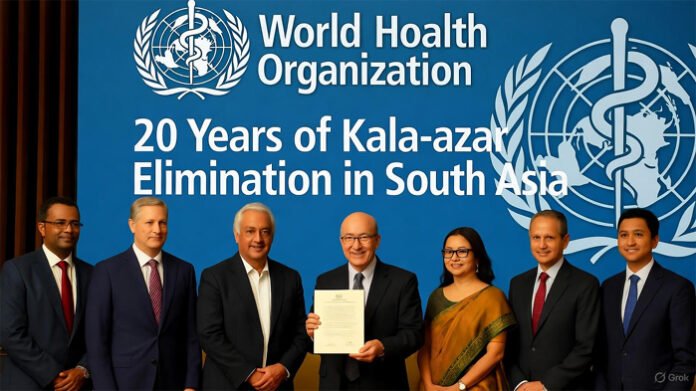Colombo, Sri Lanka — October 14, 2025
The World Health Organization (WHO) commemorated a significant milestone today, marking 20 years of the Regional Kala-azar Elimination Initiative in South Asia. This collaborative effort, launched in 2005, has led to a dramatic decline in visceral leishmaniasis (commonly known as kala-azar) cases across the region, with Bangladesh achieving a historic milestone by becoming the first country to officially eliminate the disease as a public health problem.
Bangladesh’s Historic Achievement
In October 2023, Bangladesh was certified by the WHO for eliminating kala-azar as a public health problem. This achievement was defined by the country maintaining fewer than 1 case per 10,000 population in each of its sub-districts for over three consecutive years. This success was attributed to a combination of early diagnosis, effective treatment protocols, and robust vector control measures. Former Health Minister Zahid Maleque was instrumental in these efforts, overseeing a comprehensive public health strategy that also led to the elimination of lymphatic filariasis in the same year. TIME
Progress in India and Nepal
While Bangladesh has achieved elimination, India and Nepal have made significant strides toward similar goals. In India, states like Bihar and Uttar Pradesh, which were once the epicenters of kala-azar, have reported a substantial reduction in cases due to intensified surveillance and treatment programs. Nepal has also seen a steady decline, with several districts meeting the WHO’s elimination criteria.
WHO’s Regional Strategy and Multi-Disease Approach
The WHO’s South-East Asia Regional Office (SEARO) has played a pivotal role in coordinating efforts among member states. The Regional Memorandum of Understanding (MoU), signed in 2005, laid the foundation for a unified approach to kala-azar elimination. The 20th-anniversary event, titled “Sustaining Gains, Expanding Horizons,” highlighted the success of this initiative and introduced the People-Centered Multi-Disease Elimination (MDE) approach. This new strategy aims to integrate kala-azar elimination with efforts to combat other neglected tropical diseases, thereby enhancing the efficiency and sustainability of public health interventions. World Health Organization
Challenges and the Path Forward
Despite the progress, challenges remain. In some border areas, particularly between India and Nepal, cross-border transmission continues to pose a risk. Additionally, the emergence of drug resistance and the need for continuous surveillance and vector control efforts are critical to maintaining the gains achieved. Experts emphasize the importance of sustained political commitment, community engagement, and investment in health infrastructure to achieve and sustain elimination targets.
Global Implications and Future Directions
The success in South Asia serves as a model for other regions grappling with kala-azar. The lessons learned from this initiative underscore the importance of regional cooperation, integrated health strategies, and sustained funding in tackling neglected tropical diseases. As the WHO and its partners look to the future, the focus will be on scaling up the MDE approach, addressing emerging challenges, and ensuring that the progress made in South Asia translates into global health benefits.
















